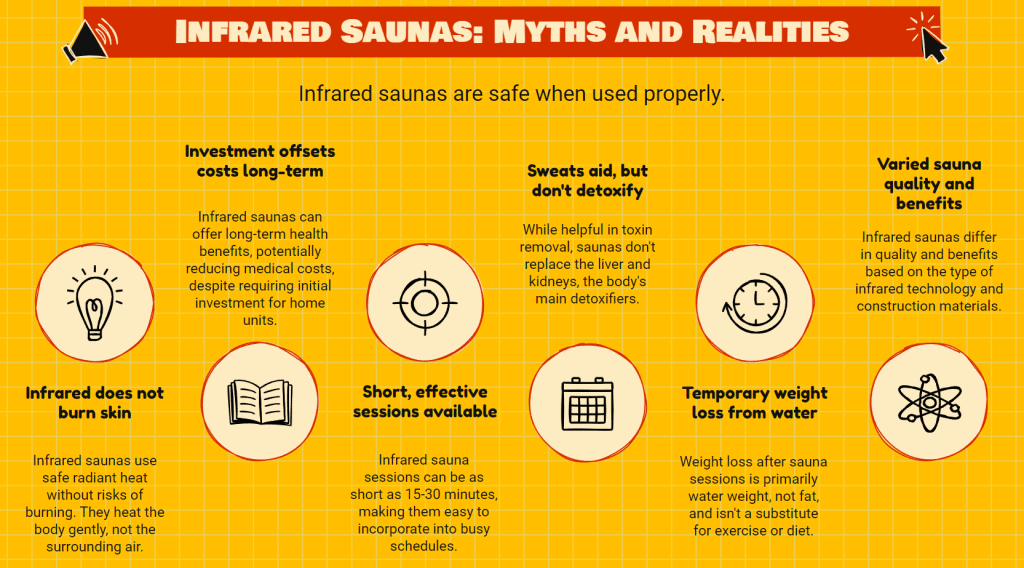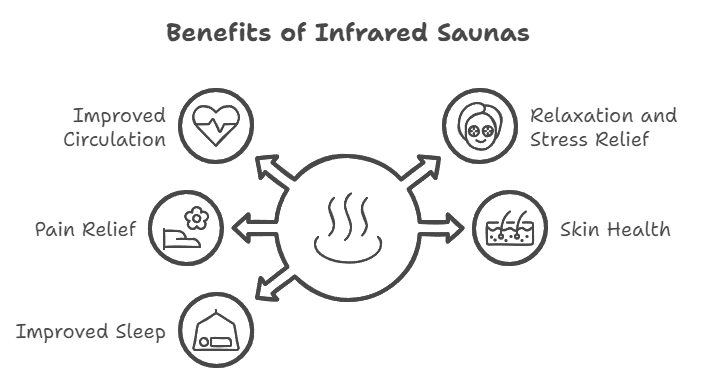Uncover the Truth: 5 Infrared Sauna Myths You Need to Know
Infrared saunas have gained popularity in recent years, promising various health benefits, from detoxification to weight loss. However, with this surge in interest comes a flood of misinformation. Let’s dive into the world of infrared sauna myths and separate fact from fiction, debunking some of the most common myths.
What are the most common misconceptions about infrared saunas?
Infrared saunas have been surrounded by various myths and misconceptions, often leading to confusion among potential users. From safety concerns to exaggerated claims about their benefits, these myths can deter people from experiencing the potential advantages of infrared sauna therapy. Let’s explore and debunk the top five myths about infrared saunas, providing accurate information to make informed decisions about your wellness journey.

Myth #1: Infrared saunas are dangerous and can burn your skin
One of the most prevalent fears surrounding infrared saunas is the misconception that they can cause skin burns or other harmful effects. This myth likely stems from a misunderstanding of how infrared technology works. Can infrared saunas burn your skin?
Reality: Infrared saunas use a gentle form of radiant heat that penetrates the skin without causing harm. Unlike traditional saunas that heat the air around you, infrared saunas directly warm your body, allowing for a more comfortable experience at lower temperatures. The infrared waves used in these saunas are within a safe spectrum and do not risk burning or damaging your skin when used as directed.
The heat emitted by infrared saunas is similar to the warmth from sunlight but without the harmful UV rays. This technology has been extensively studied and is considered safe when used properly. The infrared waves penetrate about 1.5 inches into the body, warming you from the inside out, which is why you can experience the benefits at lower temperatures than traditional saunas.
Safety Tip: While infrared saunas are generally safe, it’s essential to follow the manufacturer’s guidelines and start with shorter sessions to allow your body to acclimate to the heat. Always stay hydrated and listen to your body during sauna sessions.
Myth #2: Infrared saunas are expensive and time-consuming
Many people believe that incorporating infrared sauna therapy into their routine is a luxury they can’t afford in terms of money and time. Well, how expensive are infrared saunas?
Reality: Home units require an initial investment, but many gyms and wellness centers offer reasonable prices for infrared sauna sessions. As for time commitment, effective sessions can be as short as 15-30 minutes, making them easy to fit into even the busiest schedules. The long-term health benefits and potential savings on other wellness treatments can offset the cost over time.
When considering the cost, looking at the bigger picture is important. Regularly using an infrared sauna may improve overall health, potentially reducing medical expenses in the long run. Additionally, the time spent in a sauna can be viewed as an investment in your well-being, offering a chance to relax, de-stress, and focus on self-care.
Many spas and wellness centers offer pay-per-session options for those who can’t afford a home unit, allowing you to experience the benefits without a significant upfront cost. Some health insurance plans may even cover sauna therapy when prescribed by a healthcare provider for specific conditions.
Myth #3: Infrared saunas completely detoxify your body
A common claim is that infrared saunas can fully detoxify your body, eliminating all harmful substances through sweat. Can infrared saunas detoxify your body?
Reality: While sweating does help eliminate some toxins, it’s not a complete detoxification solution. Your liver and kidneys are the primary organs responsible for detoxification. Infrared saunas can support this process by promoting circulation and sweating, but they don’t replace the body’s natural detoxification systems.
Sweating during an infrared sauna session can help eliminate certain toxins, such as heavy metals and BPA (Bisphenol A), but it’s not a comprehensive detox method. The amount of toxins released through sweat is relatively tiny compared to what your liver and kidneys process. However, the increased circulation and sweating can support your body’s natural detoxification processes.
Health Insight: Infrared saunas can complement a healthy lifestyle by supporting your body’s natural processes, but they’re not a magic solution for detoxification. A balanced diet, regular exercise, and adequate hydration are crucial for overall health and detoxification.
Myth #4: Infrared saunas cause rapid weight loss
Some proponents claim that infrared saunas can lead to significant weight loss in a short period. Do infrared saunas help you lost weight?
Reality: While you may notice a temporary decrease in weight due to water loss through sweating, this is not permanent fat loss. Infrared saunas can support weight management efforts by increasing heart rate and metabolism, similar to light exercise. However, sustainable weight loss requires a balanced diet and regular physical activity.
During an infrared sauna session, your body’s core temperature increases, causing you to sweat and burn calories. Some studies suggest a 30-minute session can burn anywhere from 200 to 600 calories, depending on individual factors. While this calorie burn can contribute to weight loss efforts, it’s important to understand that the immediate weight loss experienced after a session is primarily due to water loss.
Infrared saunas may indirectly support weight loss by reducing stress and improving sleep quality, positively impacting weight management. However, they should be viewed as a complement to a healthy lifestyle rather than a standalone weight loss solution.
Myth #5: All infrared saunas are created equal
Many assume that all infrared saunas offer the same benefits and quality. Are all infrared saunas the same?
Reality: There can be significant differences in the quality and effectiveness of infrared saunas. Factors such as the type of infrared technology used (near, mid, or far infrared), the quality of materials, and the overall design can impact the sauna’s performance and potential benefits.
Different types of infrared waves penetrate the body to varying depths and offer different benefits:
- Near-infrared (NIR): Penetrating the skin’s surface may benefit skin health and wound healing.
- Mid-infrared (MIR): Penetrates deeper into soft tissues, potentially aiding in improved circulation and pain relief.
- Far-infrared (FIR): Penetrates the deepest, potentially offering the most significant detoxification and cardiovascular health benefits.
Some high-quality saunas combine all three types of infrared waves for a more comprehensive experience. Additionally, the materials used in construction, such as low-EMF (electromagnetic field) heaters and non-toxic wood, can contribute to a safer and more effective sauna experience.
Buying Tip: When considering an infrared sauna, research different models and read reviews to ensure you’re getting a quality product that meets your specific needs. Look for certifications and third-party testing to verify safety and effectiveness claims.
The truth about infrared saunas
Now that we’ve debunked some common myths let’s look at what science says about the potential benefits of infrared saunas:
- Improved circulation: The heat from infrared saunas can help dilate blood vessels, potentially improving circulation. This increased blood flow may contribute to better cardiovascular health and faster muscle recovery after exercise.
- Relaxation and stress relief: Many users feel relaxed and less stressed after sauna sessions. The heat can help release endorphins, the body’s natural feel-good chemicals, promoting well-being and relaxation.
- Pain relief: Some studies suggest that infrared heat may help alleviate certain types of chronic pain, such as arthritis and fibromyalgia. The deep penetration of infrared waves can help relax muscles and reduce inflammation.
- Skin health: Increased circulation and sweating may produce clearer, healthier-looking skin. The improved blood flow can deliver more nutrients to the skin while sweating can help unclog pores and remove impurities.
- Improved sleep: Regular sauna use may help regulate sleep patterns by promoting relaxation and reducing stress. The post-sauna cool-down process can also trigger your body’s natural sleep mechanisms.

It’s important to note that while these benefits are promising, more research is needed to fully understand the long-term effects of using an infrared sauna. Individual experiences may vary, and it’s always best to consult a healthcare professional before starting any new wellness routine.
Can infrared saunas cause cancer?
This is a common concern, but there’s no scientific evidence to suggest that infrared saunas cause cancer. The type of infrared radiation used in these saunas is not ionizing, which is associated with cancer risk. Infrared waves are a form of non-ionizing radiation, similar to the heat you feel from the sun or a warm object.
In fact, some studies have explored the potential of infrared therapy to support cancer treatment by enhancing the effects of certain therapies and improving patients’ quality of life. However, these studies are preliminary, and more research is needed to draw definitive conclusions.
As with any wellness practice, it’s always best to consult with your healthcare provider, especially if you have pre-existing health conditions or are undergoing cancer treatment. They can provide personalized advice based on your health status and needs.
Final Thoughts
Infrared saunas offer potential health benefits when used correctly and as part of a balanced wellness routine. By debunking these common myths, we hope to understand better what infrared saunas can and cannot do. Remember, while they can be a valuable addition to your health regimen, they’re not a cure-all solution. Always approach new wellness practices with realistic expectations and consult with healthcare professionals when in doubt.
As you consider incorporating infrared sauna sessions into your routine, focus on reputable sources of information and listen to your body. Start slowly, stay hydrated, and remember how you feel during and after sessions. With the right approach, infrared saunas can be a relaxing and potentially beneficial addition to your overall wellness strategy.
Whether you want to relax, support your fitness goals, or explore potential health benefits, infrared saunas offer a unique and enjoyable experience. As research in this field continues to evolve, we may discover more ways this technology can contribute to our well-being. In the meantime, enjoy infrared sauna therapy’s warmth and potential benefits as part of a holistic approach to health and wellness.
Frequently Asked Questions
How often should I use an infrared sauna?
For beginners, start with 1-3 weekly sessions, each lasting 10-15 minutes. As you acclimate, you can gradually increase frequency and duration based on how you feel. Always stay hydrated and listen to your body. Some people may work up to daily sessions of 30-45 minutes, but it’s essential to find a frequency that works best for you without overexertion.
Are infrared saunas safe for everyone?
While generally safe for most people, those with certain health conditions, pregnant women, and individuals taking certain medications should consult their healthcare provider before using an infrared sauna. People with cardiovascular issues, low blood pressure, or a history of heat sensitivity should be particularly cautious and seek medical advice before starting sauna therapy.
How long should you wait to shower after indoor tanning?
While this question isn’t directly related to infrared saunas, it’s important to note that you should wait at least 4 hours after indoor tanning before showering. This allows the tan to develop fully. However, if desired, infrared saunas don’t involve tanning so you can shower immediately after your session. A cool shower after an infrared sauna session can be refreshing and help bring your body temperature back to normal.
Can infrared saunas help with skin conditions?
Some users report improved skin conditions like acne and psoriasis, possibly due to increased circulation and sweating. The deep penetration of infrared waves may help improve skin tone and texture by promoting collagen production and increasing blood flow. However, results can vary, and it’s best to consult a dermatologist for persistent skin issues. They can guide you on whether infrared sauna therapy might benefit your specific skin condition and how to incorporate it safely into your skincare routine.


